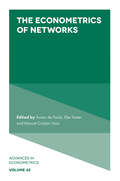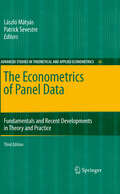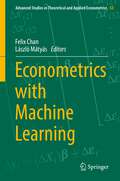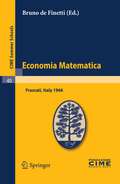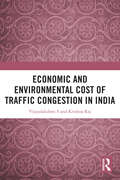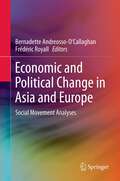- Table View
- List View
The Econometrics of Multi-dimensional Panels: Theory and Applications (Advanced Studies in Theoretical and Applied Econometrics #50)
by Laszlo MatyasThis book presents the econometric foundations and applications of multi-dimensional panels, including modern methods of big data analysis. The last two decades or so, the use of panel data has become a standard in many areas of economic analysis. The available models formulations became more complex, the estimation and hypothesis testing methods more sophisticated. The interaction between economics and econometrics resulted in a huge publication output, deepening and widening immensely our knowledge and understanding in both. The traditional panel data, by nature, are two-dimensional. Lately, however, as part of the big data revolution, there has been a rapid emergence of three, four and even higher dimensional panel data sets. These have started to be used to study the flow of goods, capital, and services, but also some other economic phenomena that can be better understood in higher dimensions. Oddly, applications rushed ahead of theory in this field. This book is aimed at filling this widening gap. The first theoretical part of the volume is providing the econometric foundations to deal with these new high-dimensional panel data sets. It not only synthesizes our current knowledge, but mostly, presents new research results. The second empirical part of the book provides insight into the most relevant applications in this area. These chapters are a mixture of surveys and new results, always focusing on the econometric problems and feasible solutions.
The Econometrics of Networks (Advances in Econometrics #42)
by Áureo De Paula, Elie Tamer, Marcel-Cristian VoiaThis volume in Advances in Econometrics showcases fresh methodological and empirical research on the econometrics of networks. Comprising both theoretical, empirical and policy papers, the authors bring together a wide range of perspectives to facilitate a dialogue between academics and practitioners for better understanding this groundbreaking field and its role in policy discussions. This edited collection includes thirteen chapters which covers various topics such as identification of network models, network formation, networks and spatial econometrics and applications of financial networks. Readers can also learn about network models with different types of interactions, sample selection in social networks, trade networks, stochastic dynamic programming in space, spatial panels, survival and networks, financial contagion, spillover effects, interconnectedness on consumer credit markets and a financial risk meter. The topics covered in the book, centered on the econometrics of data and models, are a valuable resource for graduate students and researchers in the field. The collection is also useful for industry professionals and data scientists due its focus on theoretical and applied works.
The Econometrics of Networks (Advances in Econometrics #42)
by Áureo De Paula Elie Tamer Marcel-Cristian VoiaThis volume in Advances in Econometrics showcases fresh methodological and empirical research on the econometrics of networks. Comprising both theoretical, empirical and policy papers, the authors bring together a wide range of perspectives to facilitate a dialogue between academics and practitioners for better understanding this groundbreaking field and its role in policy discussions. This edited collection includes thirteen chapters which covers various topics such as identification of network models, network formation, networks and spatial econometrics and applications of financial networks. Readers can also learn about network models with different types of interactions, sample selection in social networks, trade networks, stochastic dynamic programming in space, spatial panels, survival and networks, financial contagion, spillover effects, interconnectedness on consumer credit markets and a financial risk meter. The topics covered in the book, centered on the econometrics of data and models, are a valuable resource for graduate students and researchers in the field. The collection is also useful for industry professionals and data scientists due its focus on theoretical and applied works.
Econometrics of Panel Data: Methods and Applications
by Erik BiørnPanel data is a data type increasingly used in research in economics, social sciences, and medicine. Its primary characteristic is that the data variation goes jointly over space (across individuals, firms, countries, etc.) and time (over years, months, etc.). Panel data allow examination of problems that cannot be handled by cross-section data or time-series data. Panel data analysis is a core field in modern econometrics and multivariate statistics, and studies based on such data occupy a growing part of the field in many other disciplines. The book is intended as a text for master and advanced undergraduate courses. It may also be useful for PhD-students writing theses in empirical and applied economics and readers conducting empirical work on their own. The book attempts to take the reader gradually from simple models and methods in scalar (simple vector) notation to more complex models in matrix notation. A distinctive feature is that more attention is given to unbalanced panel data, the measurement error problem, random coefficient approaches, the interface between panel data and aggregation, and the interface between unbalanced panels and truncated and censored data sets. The 12 chapters are intended to be largely self-contained, although there is also natural progression. Most of the chapters contain commented examples based on genuine data, mainly taken from panel data applications to economics. Although the book, inter alia, through its use of examples, is aimed primarily at students of economics and econometrics, it may also be useful for readers in social sciences, psychology, and medicine, provided they have a sufficient background in statistics, notably basic regression analysis and elementary linear algebra.
Econometrics of Panel Data: Methods and Applications
by Erik BiørnPanel data is a data type increasingly used in research in economics, social sciences, and medicine. Its primary characteristic is that the data variation goes jointly over space (across individuals, firms, countries, etc.) and time (over years, months, etc.). Panel data allow examination of problems that cannot be handled by cross-section data or time-series data. Panel data analysis is a core field in modern econometrics and multivariate statistics, and studies based on such data occupy a growing part of the field in many other disciplines. The book is intended as a text for master and advanced undergraduate courses. It may also be useful for PhD-students writing theses in empirical and applied economics and readers conducting empirical work on their own. The book attempts to take the reader gradually from simple models and methods in scalar (simple vector) notation to more complex models in matrix notation. A distinctive feature is that more attention is given to unbalanced panel data, the measurement error problem, random coefficient approaches, the interface between panel data and aggregation, and the interface between unbalanced panels and truncated and censored data sets. The 12 chapters are intended to be largely self-contained, although there is also natural progression. Most of the chapters contain commented examples based on genuine data, mainly taken from panel data applications to economics. Although the book, inter alia, through its use of examples, is aimed primarily at students of economics and econometrics, it may also be useful for readers in social sciences, psychology, and medicine, provided they have a sufficient background in statistics, notably basic regression analysis and elementary linear algebra.
The Econometrics of Panel Data: Fundamentals and Recent Developments in Theory and Practice (Advanced Studies in Theoretical and Applied Econometrics #46)
by Lászlo Mátyás Patrick SevestreThis restructured, updated Third Edition provides a general overview of the econometrics of panel data, from both theoretical and applied viewpoints. Readers discover how econometric tools are used to study organizational and household behaviors as well as other macroeconomic phenomena such as economic growth. The book contains sixteen entirely new chapters; all other chapters have been revised to account for recent developments. With contributions from well known specialists in the field, this handbook is a standard reference for all those involved in the use of panel data in econometrics.
The Econometrics of Panel Data: A Handbook of the Theory with Applications (Advanced Studies in Theoretical and Applied Econometrics #33)
by László Mátyás Patrick SevestreThe aim of this volume is to provide a general overview of the econometrics of panel data, both from a theoretical and from an applied viewpoint. Since the pioneering papers by Edwin Kuh (1959), Yair Mundlak (1961), Irving Hoch (1962), and Pietro Balestra and Marc Nerlove (1966), the pooling of cross sections and time series data has become an increasingly popular way of quantifying economic relationships. Each series provides information lacking in the other, so a combination of both leads to more accurate and reliable results than would be achievable by one type of series alone. Over the last 30 years much work has been done: investigation of the properties of the applied estimators and test statistics, analysis of dynamic models and the effects of eventual measurement errors, etc. These are just some of the problems addressed by this work. In addition, some specific diffi culties associated with the use of panel data, such as attrition, heterogeneity, selectivity bias, pseudo panels etc., have also been explored. The first objective of this book, which takes up Parts I and II, is to give as complete and up-to-date a presentation of these theoretical developments as possible. Part I is concerned with classical linear models and their extensions; Part II deals with nonlinear models and related issues: logit and pro bit models, latent variable models, duration and count data models, incomplete panels and selectivity bias, point processes, and simulation techniques.
The Econometrics of Panel Data: Handbook of Theory and Applications (Advanced Studies in Theoretical and Applied Econometrics #28)
by László Mátyás Patrick SevestreThe aim of this volume is to provide a general overview of the econometrics of panel data, both from a theoretical and from an applied viewpoint. Since the pioneering papers by Kuh (1959), Mundlak (1961), Hoch (1962), and Balestra and Nerlove (1966), the pooling of cross section and time series data has become an increasingly popular way of quantifying economic relationships. Each series provides information lacking in the other, so a combination of both leads to more accurate and reliable results than would be achievable by one type of series alone. Over the last 30 years much work has been done: investigation of the properties of the applied estimators and test statistics, analysis of dynamic models and the effects of eventual measurement errors, etc. These are just some of the problems addressed by this work. In addition, some specific diffi culties associated with the use of panel data, such as attrition, heterogeneity, selectivity bias, pseudo panels etc., have also been explored. The first objective of this book, which takes up Parts I and II, is to give as complete and up-to-date a presentation of these theoretical developments as possible. Part I is concerned with classical linear models and their extensions; Part II deals with nonlinear models and related issues: logit and probit models, latent variable models, incomplete panels and selectivity bias, and point processes.
Econometrics of Planning and Efficiency (Advanced Studies in Theoretical and Applied Econometrics #11)
by Jati Sengupta Gopal K. KadekodiEconometrics of Risk (Studies in Computational Intelligence #583)
by Van-Nam Huynh Vladik Kreinovich Songsak Sriboonchitta Komsan SuriyaThis edited book contains several state-of-the-art papers devoted to econometrics of risk. Some papers provide theoretical analysis of the corresponding mathematical, statistical, computational, and economical models. Other papers describe applications of the novel risk-related econometric techniques to real-life economic situations. The book presents new methods developed just recently, in particular, methods using non-Gaussian heavy-tailed distributions, methods using non-Gaussian copulas to properly take into account dependence between different quantities, methods taking into account imprecise ("fuzzy") expert knowledge, and many other innovative techniques.This versatile volume helps practitioners to learn how to apply new techniques of econometrics of risk, and researchers to further improve the existing models and to come up with new ideas on how to best take into account economic risks.
The Econometrics of Sequential Trade Models: Theory and Applications Using High Frequency Data (Lecture Notes in Economics and Mathematical Systems #538)
by Stefan KokotThe present study has been accepted as a doctoral thesis by the Depart ment of Economics of the Johann Wolfgang Goethe-University in Frankfurt am Main. It grew out from my five year long participation in two research projects, "Econometric analysis of transaction intensity and volatility on fi nancial markets", and "Microstructure on financial markets", that were both conducted by the chair of Statistics and Econometrics (Empirical Economic Research) at the Department of Economics and Business Administration, Jo hann Wolfgang Goethe-University in Frankfurt am Main and financed by the state of Hessen. During this time I have benefitted from many people. First and foremost I would like to thank my thesis supervisor, Prof. Dr. Reinhard Hujer, for initiating and supporting my studies with great encouragement. I am also very grateful to Prof. Dr. Christian Schlag for acting as the second thesis supervisor. Furthermore, I wish to thank Prof. Dr. Joachim Grammig who introduced me to the topics covered in this study in the first place and helped me to sharpen my views on econometrics and financial market microstructure theory through many discussions and also through his willingness to work with me on several related studies.
Econometrics with Machine Learning (Advanced Studies in Theoretical and Applied Econometrics #53)
This book helps and promotes the use of machine learning tools and techniques in econometrics and explains how machine learning can enhance and expand the econometrics toolbox in theory and in practice. Throughout the volume, the authors raise and answer six questions: 1) What are the similarities between existing econometric and machine learning techniques? 2) To what extent can machine learning techniques assist econometric investigation? Specifically, how robust or stable is the prediction from machine learning algorithms given the ever-changing nature of human behavior? 3) Can machine learning techniques assist in testing statistical hypotheses and identifying causal relationships in ‘big data? 4) How can existing econometric techniques be extended by incorporating machine learning concepts? 5) How can new econometric tools and approaches be elaborated on based on machine learning techniques? 6) Is it possible to develop machine learning techniques further and make them even more readily applicable in econometrics?As the data structures in economic and financial data become more complex and models become more sophisticated, the book takes a multidisciplinary approach in developing both disciplines of machine learning and econometrics in conjunction, rather than in isolation. This volume is a must-read for scholars, researchers, students, policy-makers, and practitioners, who are using econometrics in theory or in practice.
Economia Matematica: Lectures given at a Summer School of the Centro Internazionale Matematico Estivo (C.I.M.E.) held in Frascati (Roma), Italy, August 22-30,1966 (C.I.M.E. Summer Schools #40)
by Bruno De FinettiS.N. Afriat: Economic transformation.- M. Arcelli: Modelli aumentati e principio di corrispondenza nella metodologia di Andreas.- H. Kuhn: Some remarks on games of fair division.- H. Kuhn: On two theorems in international trade.- A.G. Papandreou: Theory, construction and empirical meaning in economics.
Economic Analysis in Historical Perspective: Butterworths Advanced Economics Texts
by J. Creedy D. P. O'BrienEconomic Analysis in Historical Perspective offers a wide discussion on economics and its history. One of the book's main principles is to place the several major areas of economic analysis in historical perspective. The book's first topic is about monetary economics; it includes subtopics such as concepts of money, supply and demand of money, monetary control, and rate of interest. The next chapter highlights the economics of welfare, including its nature, modern issues, classical paradigm, and advancements. In Chapter 4, the main topics are public finance, taxes, and the government's role in all of it. This chapter also elaborates on public expenditure, taxation, and income redistribution. In the last remaining chapters, the discussion circles around the topic's relevant theories, metrics, and statistics. The text serves as a valuable reference to undergraduates or postgraduates of economics.
An Economic Analysis of Conflicts: With an Application to the Greek Civil War 1946-1949
by Nicos ChristodoulakisThis book provides a quantitative framework for the analysis of conflict dynamics and for estimating the economic costs associated with civil wars. The author develops modified Lotka-Volterra equations to model conflict dynamics, to yield realistic representations of battle processes, and to allow us to assess prolonged conflict traps. The economic costs of civil wars are evaluated with the help of two alternative methods: Firstly, the author employs a production function to determine how the destruction of human and physical capital stocks undermines economic growth in the medium term. Secondly, he develops a synthetic control approach, where the cost is obtained as the divergence of actual economic activity from a hypothetical path in the absence of civil war. The difference between the two approaches gives an indication of the adverse externalities impinging upon the economy in the form of institutional destruction. By using detailed time-series regarding battle casualties, local socio-economic indicators, and capital stock destruction during the Greek Civil War (1946-1949), a full-scale application of the above framework is presented and discussed.
The Economic Analysis of Random Events: Economic Perspectives on Probability Theory, Statistical Inference and the Nature of Chance
by Volkan HacıoğluThis book investigates applications of probability theory to random events from an economic standpoint and considers how economics can deal with uncertainty in today’s world. As such the nature of chance and probability will be discussed with examples taken from the theoretical literature in probability and the history of economic thought, as well as real-life events.Chapters cover the nature of randomness and the element of chance, the concepts of both hidden costs and opportunity costs, the economic effect of human action, the randomness of economic events, random walk hypotheses and observable and unobservable phenomena. It situates the discussion in John Maynard Keynes’ and Ronald Fisher’s seminal works on probability, as well as introducing key tenets of probability theory and how these can be applied to economic events. The book considers the relationship between artificial intelligence and economic events, the role of big data, and international examples fromdifferent economic systems and how these can be evaluated. It also introduces a multidisciplinary exploration of other social sciences and how they deal with uncertainty, to assess the extent to which it is possible to apply probability theory to economic events which are by nature erratic and uncertain.This book will be of interest to researchers and students in economics, statistics, and those in the social sciences interested in questions of randomness and chance.
The Economic Analysis of Substance Use and Abuse: An Integration of Econometric and Behavioral Economic Research (National Bureau of Economic Research Conference Report)
by Frank J. Chaloupka Warren K. Bickel Henry SafferConventional wisdom once held that the demand for addictive substances like cigarettes, alcohol, and drugs was unlike that for any other economic good and, therefore, unresponsive to traditional market forces. Recently, however, researchers from two disparate fields, economics and behavioral psychology, have found that increases in the overall price of an addictive substance can significantly reduce both the number of users and the amounts those users consume. Changes in the "full price" of addictive substances—including monetary value, time outlay, effort to obtain, and potential penalties for illegal use—yield marked variations in behavioral outcomes and demand. The Economic Analysis of Substance Use and Abuse brings these distinctive fields of study together and presents for the first time an integrated assessment of their data and results. Unique and innovative, this multidisciplinary volume will serve as an important resource in the current debates concerning alcohol and drug use and abuse and the impacts of legalizing illicit drugs.
Economic and Environmental Cost of Traffic Congestion in India
by Vijayalakshmi S S Krishna RajThis book explores one of the most prevailing problems of the contemporary urban world, i.e. traffic congestion and its economic, environmental, and health implications. Generally viewed as an urban menace, the problem of traffic congestion has huge economic implications, which are often overlooked by urban planners. This book examines and quantifies the costs and adverse consequences and of traffic congestion, which include emissions, loss of productive hours, fuel wastage, and the adverse effects on the health of commuters, among others. It provides a comprehensive and scientific understanding of the underlying problems of traffic gridlocks by analyzing empirical evidence from Bengaluru, a city in South India. It also offers solutions and highlights innovative measures that draw from both economic and engineering perspectives to counter and reduce the tangible and intangible costs of traffic conjestion. This book will be of interest to both academic and non-academic readers of economics, environmental economics and econometrics, transport economics, urban planning, transport geography, as well as planners and policy makers.
Economic and Environmental Cost of Traffic Congestion in India
by Vijayalakshmi S S Krishna RajThis book explores one of the most prevailing problems of the contemporary urban world, i.e. traffic congestion and its economic, environmental, and health implications. Generally viewed as an urban menace, the problem of traffic congestion has huge economic implications, which are often overlooked by urban planners. This book examines and quantifies the costs and adverse consequences and of traffic congestion, which include emissions, loss of productive hours, fuel wastage, and the adverse effects on the health of commuters, among others. It provides a comprehensive and scientific understanding of the underlying problems of traffic gridlocks by analyzing empirical evidence from Bengaluru, a city in South India. It also offers solutions and highlights innovative measures that draw from both economic and engineering perspectives to counter and reduce the tangible and intangible costs of traffic conjestion. This book will be of interest to both academic and non-academic readers of economics, environmental economics and econometrics, transport economics, urban planning, transport geography, as well as planners and policy makers.
Economic and Financial Modeling with Mathematica®
by Hal R. VarianMathematica is a computer program (software) for doing symbolic, numeric and graphical analysis of mathematical problems. In the hands of economists, financial analysts and other professionals in econometrics and the quantitative sector of economic and financial modeling, it can be an invaluable tool for modeling and simulation on a large number of issues and problems, besides easily grinding out numbers, doing statistical estimations and rendering graphical plots and visuals. Mathematica enables these individuals to do all of this in a unified environment. This book's main use is that of an applications handbook. Modeling in Economics and Finance with Mathematica is a compilation of contributed papers prepared by experienced, "hands on" users of the Mathematica program. They come from
Economic and Financial Modelling with EViews
by Abdulkader Aljandali Motasam TatahiThis practical guide in Eviews is aimed at practitioners and students in business, economics, econometrics, and finance. It uses a step-by-step approach to equip readers with a toolkit that enables them to make the most of this widely used econometric analysis software. Statistical and econometrics concepts are explained visually with examples, problems, and solutions.Developed by economists, the Eviews statistical software package is used most commonly for time-series oriented econometric analysis. It allows users to quickly develop statistical relations from data and then use those relations to forecast future values of the data. The package provides convenient ways to enter or upload data series, create new series from existing ones, display and print series, carry out statistical analyses of relationships among series, and manipulate results and output. This highly hands-on resource includes more than 200 illustrative graphs and tables and tutorials throughout. Abdulkader Aljandali is Senior Lecturer at Coventry University in London. He is currently leading the Stochastic Finance Module taught as part of the Global Financial Trading MSc. His previously published work includes Exchange Rate Volatility in Emerging Markers, Quantitative Analysis, Multivariate Methods & Forecasting with IBM SPSS Statistics and Multivariate Methods and Forecasting with IBM® SPSS® Statistics. Dr Aljandali is an established member of the British Accounting and Finance Association and the Higher Education Academy.Motasam Tatahi is a specialist in the areas of Macroeconomics, Financial Economics, and Financial Econometrics at the European Business School, Regent’s University London, where he serves as Principal Lecturer and Dissertation Coordinator for the MSc in Global Banking and Finance at The European Business School-London.
Economic and Management Perspectives on Intellectual Property Rights (Applied Econometrics Association Series)
by C. Peeters B. Van Pottelsberghe De La Potterie Bruno Van Pottelsberghe De La PotterieThis book provides a better understanding of how intellectual property can improve economic and business performance. It focuses on three particular issues: the valuation of patents, the transfer of knowledge, and the management of innovation and intellectual property. Scholars from leading worldwide institutions use quantitative methods and advanced survey techniques to explore the complex relationship between patents, innovation, venture capital and scientific research. The book focuses on three broad issues: the valuation of patents, the transfer of knowledge, and the management of innovation and intellectual property.
Economic and Political Change in Asia and Europe: Social Movement Analyses
by Bernadette Andreosso-O'Callaghan and Frédéric RoyallSince the 1973 publication of Alain Peyrefitte’s prophetic When China Awakens, developments in East Asia have outstripped even the wildest predictions. China has undergone the fastest industrialization and urbanization process in history, yet tensions there are rising as some realize how far they have been left behind. This volume explores the applicability of European economic and social models to our analysis of East Asia’s and, in particular, China’s situation. Though millions of Chinese and other Asian people have been lifted out of poverty, inequality is rising nonetheless, and contemporary Europe and Asia are both witnessing collective action against rampant economic neoliberalism in the former and the exclusion of minorities in the latter. It is difficult to overstate the relevance of this assessment, which seeks answers to some central questions: Can events in Europe serve as a model for those in East Asia? Are there similarities or differences between the two regions? To what extent do political, economic or social systems stimulate or inhibit collective action? How culturally equivalent are the collective actions of marginalized/ disadvantaged people in the two locations, or are events in Europe symptomatic of specific cultural attributes? Comparing and contrasting the research tools and dominant paradigms in the social and economic sciences in East Asia and Europe, as this volume does, throws out some revealing results.
Economic Applications of Quantile Regression (Studies in Empirical Economics)
by Bernd Fitzenberger Roger Koenker Jose A. F. MachadoQuantile regression has emerged as an essential statistical tool of contemporary empirical economics and biostatistics. Complementing classical least squares regression methods which are designed to estimate conditional mean models, quantile regression provides an ensemble of techniques for estimating families of conditional quantile models, thus offering a more complete view of the stochastic relationship among variables. This volume collects 12 outstanding empirical contributions in economics and offers an indispensable introduction to interpretation, implementation, and inference aspects of quantile regression.
Economic Cycles in Emerging and Advanced Countries: Synchronization, International Spillovers and the Decoupling Hypothesis (Contributions to Economics)
by Antonio PesceThis book contributes to the debate on the decoupling of emerging economies from the advanced economies with a new, empirical investigation approach. Taking counterfactual experiments performed using a time-varying panel VAR model, the author argues that over the last thirty years, emerging economies have become less vulnerable to shocks spreading from advanced economies. This resilience to external shocks has changed in a non-progressive manner over time, with phases of greater resilience followed by others of lower resilience and vice versa. This research outlines its wave-like path and presents new results that contribute to the discussion.

